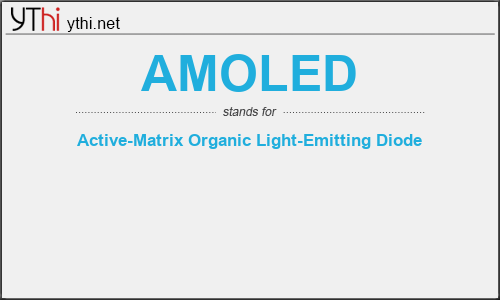What does AMOLED mean? What is the full form of AMOLED?
The full form of AMOLED is Active-Matrix Organic Light-Emitting Diode. It’s used on Technology ,Display & Graphics in Worldwide
Active matrix organic light-emitting diode (AMOLED) is a light-emitting and thin-film display technology in which electroluminescent organic compounds are placed on a base layer. With significantly less power consumption and with no backlight requirement, it is favored in displays for portable electronic devices, battery-powered devices and large displays.
AMOLED (active-matrix organic light-emitting diode, /ˈæmoʊˌlɛd/) is a type of OLED display device technology. OLED describes a specific type of thin-film-display technology in which organic compounds form the electroluminescent material, and active matrix refers to the technology behind the addressing of pixels.
An OLED (Organic Light-Emitting Diode) is similar to an LED; however, an OLED has an emissive electroluminescent layer of film made up of organic molecules. Light is emitted when electrical current travels through the organic molecules. So, why would you choose an OLED over a LCD (liquid crystal display) or VFD (vacuum fluorescent display)? Well, to answer your question, an OLED is thinner and has a better display. The OLED has a brighter, higher contrast display with faster response times, wider viewing angles, and less power consumption.
An OLED consists of 6 layers that all play a role in making the OLED well-structured and energy efficient:
- Seal: Glass top plate
- Cathode: Negatively charged electrode (attracts cations)
- Emissive Layer: Made up of organic molecules or polymers that transport electrons from the cathode layer
- Conductive Layer: Made up of organic molecules or polymers that transport holes from anode layer
- Anode: Positively charged electrode (attracts electrons or anions)
- Substrate: Glass bottom plate
AMOLED
means
Active-Matrix Organic Light-Emitting Diode![]()
Translate Active-Matrix Organic Light-Emitting Diode to other language.
Select another language: Go
Do you want to know What does AMOLED mean? What is the full form of AMOLED?. Are you looking for What does AMOLED mean? What is the full form of AMOLED? What is AMOLED stand for? On this page, We talk about the various possible acronym, abbreviation, full form or slang term of AMOLED. The Full Form of AMOLED is Active-Matrix Organic Light-Emitting Diode
You also might want to know: how to pronounce AMOLED,
how to pronounce Active-Matrix Organic Light-Emitting Diode,
Still can't find the acronym definition for AMOLED? Please use our site search to look for more acronyms.
Showing the full form of AMOLED: 'Active-Matrix Organic Light-Emitting Diode' on your site.


Leave a Reply
You must be logged in to post a comment.